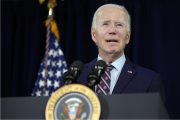
As President Trump’s recent auto, aluminum, and steel tariffs on the European Union and China have worried globalists about the possible destruction of the global trade order, U.S. Trade Representative Robert Lighthizer is simultaneously pursuing new bilateral free-trade agreements (FTAs) with the United Kingdom, Japan, the Philippines, Vietnam, and counties in sub-Saharan Africa.
On Wednesday, during his remarks at the 2018 US-Sub-Saharan African Trade and Economic Cooperation Forum, Lighthizer encouraged sub-Saharan countries to take the next step of pursuing free-trade agreements with the United States.
“I can assure you that this Administration is strongly committed to Africa,” Lighthizer said. “We want to deepen our trade ties so that workers and businesses throughout the United States and across Africa can benefit as much as possible.”
In a call to action, Lighthizer proclaimed, “We should seize the moment by pursuing a new, forward-looking vision for the future of U.S.-African trade. This vision should recognize that sub-Saharan Africa looks very different in 2018 than it did in 2000 when AGOA was first created.”
“We believe that there are countries in Africa that are ready to move from AGOA beneficiary to U.S. free trade agreement partner,” Lighthizer continued.
AGOA (African Growth and Opportunity Act) is a trade act that was approved by Congress and enacted into law by President Bill Clinton in May of 2000. Continuing Clinton’s liberal international foreign policy of building global governance through entangling “trade” agreements, President George W. Bush extended AGOA in 2004 to 2015. On June 29, 2015, President Barack Obama — also a proponent of AGOA like his predecessors Clinton and Bush — signed legislation extending AGOA to 2025.
When AGOA was originally enacted in 2000, its purpose was to provide economic assistance to participating sub-Saharan African countries in order to bring them up to the standards required for entry into formal free-trade agreements with the United States.
Now, Lighthizer believes, the time has come to take the next step toward the development of such FTAs with AGOA countries.
According to Wikipedia, “In FY2008, the United States exported $17,125,389 in goods to the 41 AGOA countries, and the U.S. imported $81,426,951 for a balance of $64,301,562 in favor of the AGOA countries.” In other words, by the year 2008, AGOA had resulted in a massive trade deficit with the United States, which is likely to deepen even further with the realization of any possible new FTA with AGOA countries.
According to the official numbers from the USTR website, “The U.S. goods and trade deficit with SubSaharan Africa countries was $1 billion in 2015.”
However, the recently published 2018 Biennial Report On The Implementation Of The African Growth And Opportunity Act, prepared by the USTR Office on June 2018, states that:
Total two-way goods trade with sub-Saharan Africa was $39 billion in 2017, up 5.8 percent compared to $36.9 billion in 2015. U.S. goods exports were $14.1 billion, down from $18.0 billion in 2015 (partly due to lower aircraft sales), while U.S. goods imports were $24.9 billion, up from $18.8 billion in 2015 (primarily due to rising commodity prices).
Meaning that the total U.S. trade deficit with AGOA countries increased to a staggering $10.8 billion, as of 2017.
Even more startling than the possibility of a further increased trade deficit with AGOA countries are the additional layers of international governance (such as any joint commissions and settlement-dispute tribunals) that would be created as a result of any new bilateral FTAs.
In fact, all of the past bilateral and multilateral FTAs that the United States has entered into over the past two decades have been subordinate to the world government-building World Trade Organization.
Take for instance the massive 696-page KORUS-FTA (Korea-United States Free Trade Agreement), which went into effect in 2012 and which the United States is concurrently renegotiating along with NAFTA. An excerpt from the preamble of the bilateral KORUS-FTA talk about the two nations “Building on their respective rights and obligations under the Marrakesh Agreement Establishing the World Trade Organization and other multilateral, regional, and bilateral agreements and arrangements to which they are both parties.”
Furthermore, Article 1.2, section 1, of the KORUS agreement states that the “Parties affirm their existing rights and obligations with respect to each other under existing bilateral and multilateral agreements to which both Parties are party, including the WTO Agreement.” In other words, the United States does not exert its full sovereignty in KORUS, despite it being a “bilateral” trade agreement; instead it affirms its rights under the World Trade Organization.
The words “World Trade Organization” and “WTO” are mentioned a total of 46 times in the KORUS-FTA. Identical language, subordinating U.S. rights under the WTO, is also found in NAFTA, CAFTA, and the U.S.-Peru FTA, and other FTAs.
Regarding which sub-Saharan African countries the United States would enter an FTA with, Lighthizer said at the AGOA Forum, “We have not made any final decision about which country or countries we will negotiate with to develop a model agreement. But I can tell you this much: We are serious and intend to move quickly. I hope to announce exploratory talks soon.”
Foreign policy and trade analysts have suggested that Kenya, Ghana, and Côte d’Ivoire are top contenders for potential FTAs with the United States.
Lighthizer’s remarks at the AGOA Forum reiterated what Assistant USTR for Africa Constance Hamilton said during a State Department briefing call on Monday: “The [Trump] administration wants to continue to build on AGOA’s success by strengthening bilateral trade relationships in sub-Saharan Africa and perhaps by initiating exploratory talks to consider bilateral free trade area agreements,” Hamilton said.
Lighthizer concluded his remarks envisioning a U.S. economic merger with Africa. “We hope we can work with a willing partner to create an agreement that can serve as a template for additional deals on the continent. Doing so would build on the success of AGOA and reinforce the larger project of regional economic integration with Africa.” (Emphasis added.)
In other words, the purpose of the proposed new FTAs with sub-Saharan AGOA countries is not a fulfillment of Jeffersonian “commerce with all nations” or simply acquiring access to more foreign markets for U.S. companies, but rather, as Lighthizer put it, to “reinforce the larger project of regional economic integration with Africa.” Lighthizer did not say economic integration “in Africa,” as in merely within the African Union. Instead he meant the United States merging its economy together with the economies of African countries. This sounds likes the development of a common market such as the Eurozone.
The United States has previously pursued developing such common markets with countries in the Pacific-Rim through the Trans-Pacific Partnership (TPP), the European Union via the Transatlantic Trade and Investment Partnership (TTIP), and in the Western Hemisphere with all of North, Central, and South America through the proposed Free Trade Area of the Americas (FTAA).
All of these efforts to abrogate U.S. sovereignty and independence have failed due largely to the efforts of The John Birch Society, which educated U.S. citizens about the ramifications of entering into such “trade” agreements and activating those citizens to apply pressure to their elected officials to oppose U.S. participation.
In addition to economically merging the United States with Africa, Lighthizer also has his eyes set on possible FTAs with the United Kingdom, Japan, the Philippines, and Communist Vietnam.
On Friday, President Trump will meet with British Prime Minister Theresa May, during his three-day visit to the U.K. According to U.S. Ambassador to the U.K. Woody Johnson, getting a U.S.-U.K. FTA is a top priority for Trump.
“The president has been clear right from the beginning, really, of his term,” Ambassador Johnson said. “He said, he’d ‘love to do a bilateral trade deal.’ And he’s really ready to step up on that the minute we get the go-ahead to do it. And he’ll get it done fast because I know it’s a major priority for him.”
Any potential U.S. FTA with the U.K. would have to wait until the U.K. has formally withdrawn from the European Union, which it is currently in the process of negotiating.
Testifying before the House Ways and Means Committee in March, Lighthizer said that the Philippines would be a “reasonable” country for an initial FTA in the Asia-Pacific. In addition to the Philippines, Lighthizer told Representative Devin Nunes (R-Calif.), during his testimony, “Vietnam is one that there’s been a number of members and people in the administration who also think we ought to be moving there.” Lighthizer did not name who specifically within the Trump administration would like to see the United States pursue greater trade relations with the communist dictatorship in Southeast Asia.
Later this month, Lighthizer is also expected to meet with Japan’s Minister of State for Economic and Fiscal Policy Toshimitsu Motegi. Lighthizer and Motegi will “discuss how best to realize free, fair, and reciprocal trade,” Japan Today reports.
However, if both Lighthizer’s remarks about the United States economically integrating with Africa and the aforementioned subordination to WTO authority contained in past FTAs are any indication, then the possibility of more FTAs, including “bilateral” ones, with the U.K., Philippines, Vietnam, and Japan will not bode well for U.S. sovereignty.
For any trade agreement to be truly free and likewise ensure the sovereignty of the United States and the other willing nation involved, then it must be free of any foreign oversight in which both parties are subordinate to governing rules and authority.
Real free trade necessitates freedom from the global governance structures of the WTO, and must not seek the economic merger of the countries involved. Otherwise, the result is convergence — eroding and replacing national sovereignty and independence with eventual world government, rather than open trade between two free and sovereign nations.
Lighthizer’s proposed “bilateral” FTAs with AGOA countries, the Philippines, Vietnam, Japan, and the U.K. would only strengthen America’s interdependence under the World Trade Organization rather than America’s independence.





